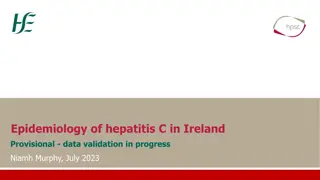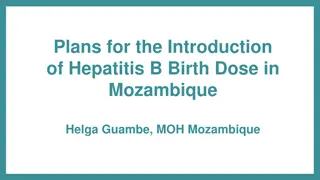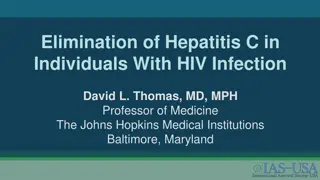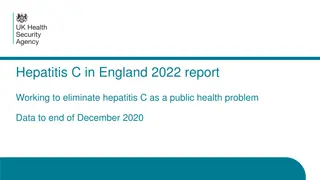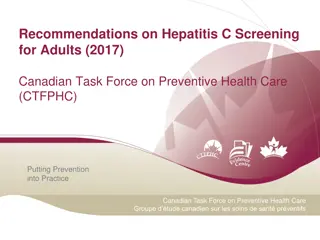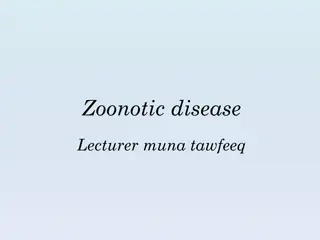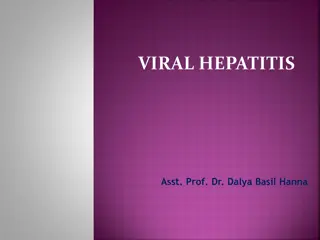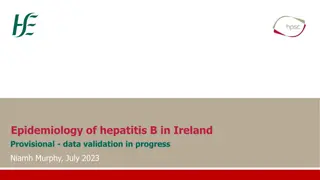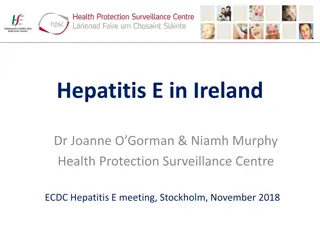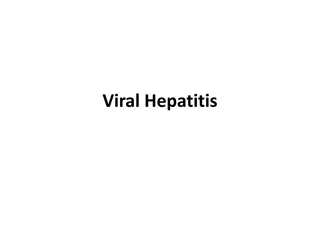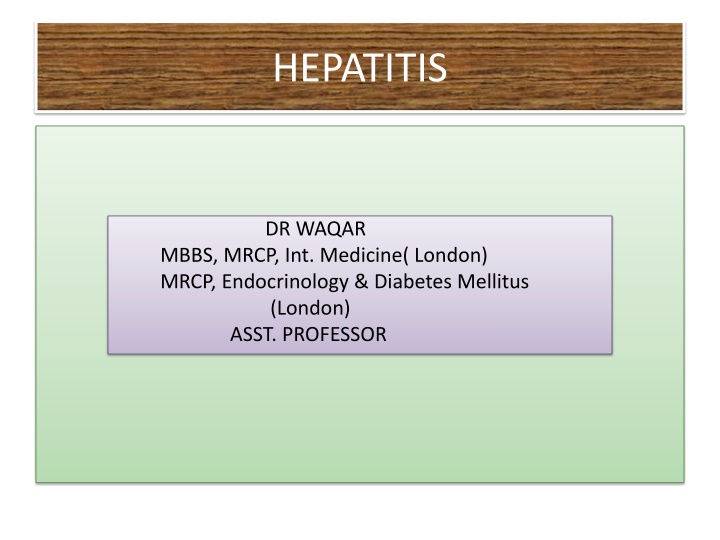
Hepatitis: Causes, Symptoms, and Treatment
Learn about hepatitis, an inflammation of the liver, caused by various factors including viruses, drugs, autoimmune conditions, and alcohol. Explore the types of viral hepatitis, differences between acute and chronic hepatitis, and detailed information on Hepatitis A, including its transmission, clinical features, severity, investigations, and treatment options.
Download Presentation

Please find below an Image/Link to download the presentation.
The content on the website is provided AS IS for your information and personal use only. It may not be sold, licensed, or shared on other websites without obtaining consent from the author. If you encounter any issues during the download, it is possible that the publisher has removed the file from their server.
You are allowed to download the files provided on this website for personal or commercial use, subject to the condition that they are used lawfully. All files are the property of their respective owners.
The content on the website is provided AS IS for your information and personal use only. It may not be sold, licensed, or shared on other websites without obtaining consent from the author.
E N D
Presentation Transcript
HEPATITIS DR WAQAR MBBS, MRCP, Int. Medicine( London) MRCP, Endocrinology & Diabetes Mellitus (London) ASST. PROFESSOR
HEPATITIS It means inflammation of the hepatocytes. There are many etiologies of hepatitis : 1) Viruses: Most common cause 2) Drugs ( panadol, INH) 3) Ischemia of liver( ischemic hepatitis) 4) Autoimmune5) Alcohol Treatment is steroids
VIRAL HEPATITIS Common A, B, C, D, E * Epstein Barr virus(EBV) ( more common) * Cytomegalovirus(CMV) * Other rare viruses ( less common) Uncommon
Hepatitis can be acute or chronic. 1) Acute: Duration of the disease is less than 6 months. 2) Chronic: Duration is more than 6 months (clinical S/S or abnormal blood tests) *Hep A causes only acute hepatitis *Hep B,C,D &E can cause both, acute & chronic. Chronic hepatitis B & C is the main cause of chronic liver disease, cirrhosis & hepatic cancer
HEPATITIS A 1) Most common cause of acute viral hepatitis. 2) Causes only acute hepatitis. No carrier state or chronic hepatitis. Usually, does not happen twice. Mode of transmission: Fecal-oral route( contamination of food & water due to poor hygiene by food handlers) Saliva of the infected person also contains the virus but very little amount
Hep A contd. Clinical Features: Prodromal Phase ( initial 1 -2 wks) * Anorexia,nausea, malaise, bad taste, fever *Jaundice is absent initially Icteric Phase (next 3-6 wks) * Jaundice, pain in right upper quandrant, dark urine, pale stools, tender hepatomegaly
SEVERITY OF HEP A Asymptomatic Usually mild to Fulminant moderate S/S hepatic failure usually in children most cases
Hep A contd. INVESTIGATIONS 1) L.F.T.s: * High bilirubin ( mainly direct) * AST & ALT are very high * Alk. Phosphatase slightly high 2) Urine : Contains bilirubin ( which type? ) 3) Diagnostic test: *Hepatitis A antibody (anti HAV)
TREATMENT There is no special drug treatment. Disease is self limited and usually there is complete recovery within 3 months. STRICT ISOLATION OF THE PATIENT IS NOT ADVISED BUT THEY SHOULD WASH THEIR HANDS AFTER DEFECATION 1) Good nutrition( whatever can be tolerated) 2) Vitamin supplements 3) Avoid alcohol & hepatotoxic drugs 4) Symptomatic treatment
PREVENTION General Measures * Good hygiene * Hep.A vaccine * Drink bottled water in high risk areas * Avoid risky foods 1) Vaccine: Hep A vaccine is given to the following people: * Patients with other chronic liver disease * Patients going to a high risk area for a long time Immunization
RAPID FIRE QUESTIONS 1) Mode of transmission of hep A? 2) Which test is diagnostic? 3) In hepatitis, which type of bilirubin is elevated predominantly? 4) Which specific drug for hep A treatment? 5) Who shud get hep A vaccine? 6) How to avoid getting infected? 7) A man tells you that he had hep A 2 years ago. Now he is jaundiced. The doctor tells him that he has hep A re- infection. Is the doctor right?
HEPATITIS B Epidemiology: * World wide problem( specially Africa, Mid- East, S.America) * 1/3rd of the world population has serological evidence of past or present infection. * About 1 million deaths occur per year due to Hep B related liver disease & carcinoma
Structure of Hep B virus 1) Outer covering has surface antigen( s ag.) 2) Inner center has: * e ag.(envelop antigen) * c ag. * DNA (so, 3 ag. plus DNA) It is a DNA virus ( hep A & hep C are RNA viruses)
SEROLOGIC MARKERS 1) After infection wth Hep B, s antigen, e ag. & HepB DNA are detectable in the blood. 2) c antigen is not detectable in the blood. Antibodies which appear in the blood (& clear the infection) * Anti HB s ( against s ag.) * Anti HB e ( against e ag.) * AntiHB c ( against c ag.) Note that c antigen is not detectable in blood but c antibody can be detected
* APPEARANCE OF ANTI HBs & ANTI HBe MEANS INFECTION IS RESOLVED * ANTI c does not kill the virus
Routes of Transmission 1) VERTICAL 2) PARENTERAL (mother to fetus) * Most common route worldwide. Modes of parenteral transfer 1) Needle sharing (i.v. drugs, tattooing) 2) Transfusion of infected blood & blood products: V. rare in developed countries coz of blood screening. 4) Needle stick injuries ( doctors &nurses at high risk) 5) Sexual transmission 6) Direct contact with blood of HepB patient ( even small skin breaks are risky)
Saliva, sweat and tears also contain the virus but they are not considered as very significant modes (may spread)
SPECTRUM OF HEP.B INFECTION Hep. B can cause any of the following: 1) Acute hepatitis : Duration less than 6 months 2) Chronic hepatitis: Duration more than 6 months Chronic hep B is of further 2 types : a) Chr. Active hepatitis b) Chr. Carrier state ( details in later slides)
ACUTE HEP. B 1) Incubation Period: Very variable. Avg. 6 wks 2) S/S : * Jaundice + all others like Hep A * May be asymptomatic A) Blood Tests: a) LFTs: bili., AST & ALT (same like hepA) b) Hep B serology ( antigens & antibodies) SEE NEXT FEW SLIDES
SEROLOGY IN ACUTE HEP B 1) Antigens which appear * s ag. * e ag. * HepB DNA levels 2) Antibodies which appear: AntiHBs means * Anti Hbe recovery AntiHBc Once antibodies appear, antigens disappear & infection is resolved. ( Disappearance of antigens & appearance of antibodies is called SEROCONVERSION)
ANTI c ANTIBODY: * does not kill the virus * appears early in infection & persists for ever * Initially, it is of IgM type, then changes to IgG type.
SOME POINTS 1) s antigen is the first to appear in blood 2) e antigen is highly infectious 3) WINDOW PERIOD: It is the time period in acute hepatitis B when the infection has just resolved. s ag. has disappeared but antiHBs antibody is till umeasurable. The only thing positive during this period is anti HBc, Ig M type (antibody to the c antigen)
Treatment of Acute Hep B Symptomatic Usually, no specific treatment in acute cases
CHRONIC Hep B Chronic active Carrier state Hepatitis ( Infection present for more than ? )
Chronic Active Hep B * Infection present for more than 6 months * Patient may or may not have symptoms * LFTs raised & liver biopsy abnormal * s antigen, e antigen , hep B DNA present in blood * patient highly infectious ( because e ag. is present) * More chances of chronic infection in children & people with poor immunity( DM, long term steroid use, HIV etc)
Chronic Carrier State * Infection present for more than 6 months. * Patient asymptomatic * LFTs & biopsy are normal * s antigen present in the blood * No e antigen in the blood (so patient is much less infectious) * DNA levels may be low or absent in the blood So : s antigen yes, e antigen no, Hep B DNA low or absent in the blood
COMPARISON Chronic active hep B Chronic carrier state 1) Patient usually symptomatic 2) LFTs & liver biopsy abnormal 3) e ag. usually present 4) Hep B DNA levels high in the blood 5) Treatment is given 1) Patient usually asymptomatic 2) LFTs & biopsy norm. 3) e ag absent 4) Hep B dna levels low or absent 5) Treatment not given
SEROLOGIES IN DIFFERENT PHASES 1) Acute hep B : a) s ag. Positive b) e ag. Positive c) Anti c positive (IgM type) d) Anti s neg. & anti e neg 2) Resolved infection: a) s ag. Neg. b) e ag. Neg. c) Anti c pos.( Ig G type) d) Anti s pos. e) Anti e positive
3) Window period: a) s ag. Neg b) e ag neg. c) Anti c positive (IgM type) d) Anti s neg. 4) Chronic hepatitis (active & carrier) a) s ag. Positive b) e ag. Positive c) Anti c pos. (IgG type) d) Anti s neg. e) Anti e negative
SO Look for s antigen first Positive Infec. MOJOOD No infection a. Acute infec a. never infected b. Chr active b. resolved infec c. Chr carrier c. window period d. Vaccinated Negative
TREATMENT OF CHR. HEP B Drugs Liver transplant
TREATMENT OF CHR.HEP B 1) Drugs used: * Nucleoside analogues: eg Entecavir oral * Nucleotide analogues: eg. Tenofovir drugs * Interferon ( Injections) 2) Treatment is 6 months to 1 yr. 3) Treatment is not given to chronic carriers ( patients who have only s antigen positive with normal LFTs & normal liver biopsy)
Liver transplant is done in end stage liver disease or fulminant hepatic failure So: * Acute hep B: no antiviral meds * Chr. Active hep B: antiviral meds yes * Chr carrier : no meds
PREVENTION OF HEP B. 1) Avoid risk factors ( iv drugs, needle sharing, sexual contact wth. unknown or HepB positive person, avoid direct contact wth blood, no sharing of razors etc. 2) Vaccine: Given routinely to everyone. * 3 doses: 0, I month,6 mnth (from the 1st dose) 3) Immune globulins: Given for immediate protection, if : * Needle stick injury from a hep. B patient * Sexual exposure to hep B patient * Newborn baby ( if mother is hep B positive)
Immunoglobulins are JAAHIZ antibodies against the virus, available in ampoules. They provide quick but short term immunity. Vaccines take time to be effective but provide long term immunity
COMPLICATION OF CHR.HEP B a) Cirrhosis b) Hepatic carcinoma REMEMBER * Vaccine produces protective antibody after some time (wks to months) but lasts long. * Immunoglobulins provide immediate protection that lasts for a short time.
Hep B & pregnancy High chances of vertical transmission, so Hep B positive mother should be treated Tenofovir is safe to give during pregnancy Breast milk does not transmit the infection to the baby What to do to the baby who is born to a hep B positive mother? LISTEN TO ME !
RAPID FIRE QUES FOR HEP B 1) What are the modes of transmission? 2) Name the 3 antigens of hep B? 3) Which antibody is not detectable in the serum? 4) Which antibody is not protective ( does not kill the virus? 5) Of all the antigens, which is the most important to check to see infection? 6) Appearance of which antibodies means infection is resolved?
7) Saliva, sweat and tears of hep B patient are highly infectious, right or wrong? 8) Duration of acute hep B? 9) Duration of chronic hep B? 10) Name the 2 types of chronic hep B? 11) Name 2 differences between the 2? 12) What will LFTs show in acute hep B? 13) What do you mean by seroconversion ?
14) In the window period, what is detectable in the blood? 15)Which antiviral drug to treat acute hep B? 16) In acute hep B, what is detectable in the blood? 17) Which drug to use for chr carrier state/ 18) Name the drugs used for hep B Rx? 19) Whats the vaccination schedule for hep B?
20) Who should get vaccination? 21) What to give immediately after exposure? 22) Vaccines provide quick immunity, right or wrong? 23) Complications of chronic hep B? 24) Hep B is a contraindication to for pregnancy, right or wrong? 25) What to give to the pregnant lady who has chr. hep B?
26) During pregnancy, hep B virus goes to the baby during which trimester? 27) Baby born to a hep B mother. How to deal with?
HEP C 1) Epidemiology: Occurs worldwide but very common in Africa & Egypt. Prevalence in KSA : 1% 2) Mode of Spread: (Parenteral) * i.v. drug use ( West) * Blood transfusion (developing countries) * Contaminated needles & instruments (surg., dental) * Sexual transmission is very less(<1%) *Perinatal : <1% * Contact with infected blood( razors, cuts) 3) There are 7 subtypes of HepC ( 1 to 7)
WHAT HAPPENS AFTER INFECTION 1) Few patients (10-20%) get mild acute hepatitis which resolves and the infection gets cleared. 2) Most patients develop chronic hepatitis CHRONIC HEP C 1) Usually asymptomatic & detected by chance on routine blood tests(slightly high AST & ALT). LFTS often fluctuate. 2) Often presents as cirrhosis after many years 3) Mild jaundice, fatigue may occur
DIAGNOSIS (HEP C) 1) Hep C antibody ( Anti HCV ab.) * It is the initial test done * Can be detected in the blood about 2 months after infection * Thisantibody is not protective(opposite of Hep B) 2) HepC RNA levels (by PCR): * This is actual virus level in the blood * Can be detected in blood after 1-2 wks of infec. ( earlier than antibody) 3) Liver Biopsy: Not done routinely for diagnosis, but only done before treatment to see disease severity
TREATMENT 1) Offered to most patients 2) Response to treatment depends on genotype ( 1 to 7) & some other factors (type 2 & type 3 Hep C have very good response to treatment) 3) Latest treatments are mainly oral drugs. Sometimes, interferon can be added.
Drugs Used In Hep C 1) RIBAVIRIN : Used in combination with other drugs. 2) Direct acting antivirals( DAA): * Ledi-pasvir, *Sime-previr * Sofos-buvir 3) Interferon : Sometimes added to the above. Generally speaking, treatment is for 3 months.
OTHER THINGS IN MANAGEMENT 1) Patient counselling: * Don t donate blood or tissue * No iv drugs, no needle/razor sharing * Explain that there is a small risk of sexual transmission * Avoid alcohol ( can worsen the disease) 2) Check for Hep B & Hep A and vaccinate if negative for these 3) Check for HIV

